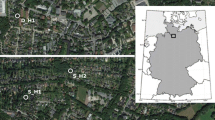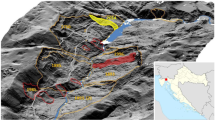Abstract
The performance of managed artificial recharge (MAR) facilities by means of surface ponds (SP) is controlled by the temporal evolution of the global infiltration capacity I c of topsoils. Cost-effective maintenance operations that aim to maintain controlled infiltration values during the activity of the SP require the full knowledge of the spatio-temporal variability of I c . This task is deemed uncertain. The natural reduction in time of I c depends on complex physical, biological and chemical reactions that clog the soil pores and has been observed to decay exponentially to an asymptotic non-zero value. Moreover, the relative influence of single clogging processes depend on some initial parameters of the soil, such as the initial infiltration capacity (I c,0). This property is also uncertain, as aquifers are typically heterogeneous and scarcely characterized in practical situations. We suggest a method to obtain maps of I c using a geostatistical approach, which is suitable to be extended to engineering risk assessment concerning management of SP facilities. We propose to combine geostatistical inference and a temporally-lumped physical model to reproduce non-uniform clogging in topsoils of a SP, using field campaigns of local and large scale tests and additionally by means of satellite images as secondary information. We then postulate a power-law relationship between the parameter of the exponential law, λ, and I c,0. It is found that calibrating the two parameters of the power law model it is possible to fit the temporal evolution of total infiltration rate at the pond scale in a MAR test facility. The results can be used to design appropriate measures to selectively limit clogging during operation, extending the life of the infiltration pond.









Similar content being viewed by others
References
Almeida A, Journel A (1996) Joint simulation of multiple variables with Markov-type coregionalization model. Math Geol 26(5):565–588
Barahona-Palomo M, Pedretti D, Sanchez-Vila X (2010) Infiltration tests at the Sant Vicenç dels Horts artificial recharge experimental site. In: EGU General Assembly 2010 (ed) Geophysical Research Abstracts, EGU2010-5326, vol 12
Baveye P, Vandevivere P, Hoyle BL, de Leo PC, de Lozada Sanchez D (1998) Environmental impact and mechanisms of the biological clogging of saturated soils and aquifer materials. Crit Rev Environ Sci Technol 28(2):123–191. doi:10.1080/10643389891254197
Bedford T, Cook R (2001) Probabilistic risk analysis: foundations and methods. Cambridge University Press, New York
Bolster D, Barahona-Palomo M, Dentz M, Fernàndez-Garcia D, Sanchez-Vila X, Trinchero P, Valhondo C, Tartakovsky DM (2009) Probabilistic risk assessment applied to contamination scenarios in porous media. Water Resour Res 45:W06,413. doi:10.1029/2008WR007.551
Bouwer H (1999) Artificial recharge of groundwater: system design, and management. In: Mays LW (ed) Hydraulic design handbook. McGraw-Hill, New York. pp 24.1–24.44
Bouwer H (2002) Artificial recharge of groundwater: hydrogeology and engineering. Hydrogeol J. doi:10.1007/s10040-001-0182-4
Carman P (1938) The determination of the specific surface of powders. J Soc Chem Ind Trans 57:225
Carrera J, Vazquez-Sune E, Abarca E, Capino B, Gamez D, Simo A, Ninerola J, Queralt E (2005) El baix Llobregat. Historia i actualitat ambiental d’un riu, chap Les aigues subterranies del Baix Llobregat. pp 72–92
Chica-Olmo M, Abarca-Hernandez F (2000) Computing geostatistical image texture for remotely sensed data classification. Comput Geosci 26:373–383
Civan F (2007) Temperature effect on power for particle detachment from pore wall described by an Arrhenius-type equation. Trans Porous Med 67(2):329–334
Civan F (2010) Non-isothermal permeability impairment by fines migration and deposition in porous media including dispersive transport. Transp Porous Med. doi:10.1007/s11.242-010-9557-0
Clement TP, Hooker BS, Skeen RS (1996) Macroscopic models for predicting changes in saturated porous media properties caused by microbial growth. Groundwater 34(5):934–942
Cunningham AB, Characklis WG, Abedeen F, Crawford D (1991) Influence of biofilm accumulation on porous media hydrodynamics. Environ Sci Technol 25:1305–1311
Custodio E (2002) Aquifer overexploitation: what does it mean? Hydrogeol J 10:254–277. doi:10.1007/s10040-002-0188-6
de Barros FPJ, Rubin Y (2008) A risk-driven approach for subsurface site characterization. Water Resour Res 58:W01,414. doi:10.1029/2007WR006081
Deutsch C, Journel A (1998) Gslib: geostatistical software library and user’s guide. Tech. rep., Oxford University Press, New York
Gooverts P (1997) Geostatistics for environmental applications. Oxford University Press, USA
Granger R (2000) Satellite-derived estimates of evapotranspiration in the gediz basin. J Hydrol 229:70–76
Greskowiak J, Prommer H, Massmann G, Johnston CD, Nützmann G, Pekdeger A (2005) The impact of variable saturated conditions on the hydrochemistry during artificial recharge of groundwater—a field study. Appl Geochem 20:1409–1426
Guin JA (1972) Clogging of nonuniform filter media. Ind Eng Chem Fundam 11(3):345–349. doi:10.1021/i160043a010
Hazen A (1882) Some physical properties of sands and gravels, with special reference to their use in filtration. 24th Annual Rep, Massachusetts State Board of Health. Pub Doc 34:539–556
Hoffmann A, Gunkel G (2010) Bank filtration in the sandy littoral zone of Lake Tegel (Berlin): Structure and dynamics of the biological active filter zone and clogging processes. Limnologica—Ecology and Management of Inland Waters In Press, Corrected Proof. doi:10.1016/j.limno.2009.12.003, http://www.sciencedirect.com/science/article/B7GX1-4YK88XC-1/2/5b4d8b5a1ed550ecf8d24cc17b40d993
Iwasaki T (1937) Some notes on sand filtration. J Am Water Works Assoc 29:1597–1602
Journel A (1999) Markov models for crosscovariances. Math Geol 31(8):955–964
Kim JW, Choi H, Pachepsky YA (2010) Biofilm morphology as related to the porous media clogging. Water Res 44(4):1193–1201. doi:10.1016/j.watres.2009.05.049, http://www.sciencedirect.com/science/article/B6V73-4WNGW5F-1/2/0a7f4de465f62adf795d4bbbc3ea3dab, transport and Fate of Colloids and Microbes in Granular Aqueous Environments
Kozeny J (1927) Uber Kapillare Leitung des Wassers im Boden. Sitzungsber Akad Wiss Wien 136:271–306
Krzysztofowicz R (2001) The case for probabilistic forecasting in hydrology. J Hydrol 249:2–9
Management of aquifer recharge and subsurface storage (2003) Netherlands National Committee—International Association of Hydrogeology, No. 4. NNCIAH Publication
Masetti M, Sterlacchini S, Ballabio C, Sorichetta A, Poli S (2009) Influence of threshold value in the use of statistical methods for groundwater vulnerability assessment. Sci Total Environ 407(12):3836–3846. doi:0.1016/j.scitotenv.2009.01.055, http://www.sciencedirect.com/science/article/B6V78-4W0R3BY-1/2/80d0bac534dd772455927723f038fd98, thematic Issue—BioMicroWorld Conference
Milewskia A, Sultana M, Yanb E, Beckera R, Abdeldayemc A, Solimand F, Gelil K (2009) A remote sensing solution for estimating runoff and recharge in arid environments. J Hydrol 373(1–2):1–14
Monod J, Wyman J, Changeux JP (1965) On the nature of allosteric transitions: a plausible model. J Mol Biol 12:88–118
Okubo T, Matsumoto J (1979) Effect of infiltration rate on biological clogging and water quality changes during artificial recharge. Water Resour Res 15(6):1536–1542. doi:10.1029/WR015i006p01536
Olsthoorn T (1982) The clogging of recharge wells, main subjects. Tech. rep., Working group on recharge wells. Riswijk, The Netherlands. 136 pp
Pedretti D, Barahona-Palomo M, Bolster D, Fernàndez-Garcia D, Sanchez-Vila X (2010) Spatial assessment of infiltration capacity of soils for artificial recharge practices using Google Earth images. Proceedings of the GeoENV Conference, Ghent University, Ghent (Belgium)
Pedretti D, Barahona-Palomo M, Bolster D, Sanchez-Vila X, Fernàndez-Garcia D, Tartakovsky D (under review) Probabilistic analysis of maintenance and operation of artificial recharge ponds. Adv Water Resour
Perez-Paricio A, Carrera J (1999) Clogging handbook. Tech. rep., Final report, EU project on Artificial Recharge of Groundwater
Scanlon BR, Keese KE, Flint AL, Flint LE, Gaye GB, Edmunds WM, Simmers I (2006) Global synthesis of groundwater recharge in semiarid and arid regions. Hydrol Process 20:3335–3370
Smith R (1972) The infiltration envelope: results from a theoretical infiltrometer. J Hydrol 17:1–21
Tartakovsky DM (2007) Probabilistic risk analysis in subsurface hydrology. Geophys Res Lett 34:L05,404. doi:10.1029/2007GL029.245
Tartakovsky DM, Winter CL (2008) Uncertain future of hydrogeology. ASCE J Hydrol Eng 13(1):37–39
Tien C, Payatakes AC (1979) Advances in deep bed filtration. AIChE J 25(5):737–759
Vandevivere P, Baveye P (1992) Relationship between transport of bacteria and their clogging efficiency in sand columns. Appl Environ Microbiol 58(8):2523–2530
Vandevivere P, Baveye P, de Lozada DS, DeLeo P (1995) Microbial clogging of saturated soils and aquifer materials: evaluation of mathematical models. Water Resour Res 31(9):2173–2180
Zamani A, Maini B (2009) Flow of dispersed particles through porous media—deep bed filtration. J Pet Sci Eng 69:71–88
Acknowledgments
This project was financially by the Spanish Ministry of Science and Innovation via the CONSOLIDER-Ingenio 2010 (CSD2009-00065), RARA-AVIS (CGL2009-11114) and HEROS (CGL2007-66748) projects. DP would like to further acknowledge the Spanish government for funding through the FPU scholarship programme (Formation of University Lecturers).
Author information
Authors and Affiliations
Corresponding author
Rights and permissions
About this article
Cite this article
Pedretti, D., Fernàndez-Garcia, D., Sanchez-Vila, X. et al. Combining physical-based models and satellite images for the spatio-temporal assessment of soil infiltration capacity. Stoch Environ Res Risk Assess 25, 1065–1075 (2011). https://doi.org/10.1007/s00477-011-0486-4
Published:
Issue Date:
DOI: https://doi.org/10.1007/s00477-011-0486-4




